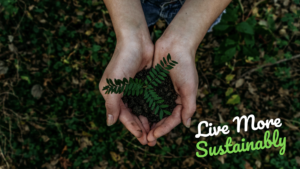UCanMakeItIfYouTry – Live More Sustainably
Our oceans are full of items that continually threaten wildlife. Plastic and trash constantly overrun landfills. We hear about reducing our carbon footprint and recycling, but is it possible to make a difference? Absolutely! Now is always a good time to change habits and learn to live more sustainably.
1 – Rethink Your Shopping Habits
When shopping, look for minimally packaged items or buy in bulk and use glass jars to store smaller portions at home. Many products have extra packaging they don’t need. The packaging ends up clogging our landfills for years.
2 – Buy a Water Filter and Use Tap Water
Avoid buying single-use plastic water bottles. Invest in a reusable bottle and water filter. This keeps many non-biodegradable plastics out of landfills – and it’s much cheaper!
3 – BYOB at the Store (Bring Your Own Bags)
Plastic bags used by grocery stores often wind up in the trash instead of the recycle bin. Invest in a few canvas totes to take with you to the store, or opt for paper sacks if you forget.
4 – Reduce Water Use
Harvest rainwater for your garden or lawn. If you have a dishwasher, use it. The energy used to run it is much less than if you run water from your faucet to wash them by hand. Install a low-flow shower head or one you can switch off while soaping. Be sure to fix any water leaks around the house.
5 – Cook at Home
You save money, your waistline, and carbon emissions while cooking at home. An added benefit is knowing what you put into your dinner when you use whole foods. Also, cook what you need or freeze leftovers to avoid throwing out and wasting food.
6 – Reduce the Amount of Meat You Consume
Animals give off quite a bit of CO2 emissions, especially beef. You don’t have to completely cut out red meat, dairy, cheese, or other favorites. Institute a meatless meal once or twice a week can help the environment and your waistline.
7 – Buy and Consume Less
Take time before purchasing to determine if it is a need or a want. Needs include food, clothing, and shelter, but that doesn’t mean you have to indulge in overconsumption. Buy what you truly need and leave the rest at the store.
8 – Rethink Your Wardrobe
Adding new fashion items to your wardrobe is fun, but some fashion items have a short shelf-life. Look for classic items that are well-made and higher-quality. Consider buying second-hand items and those made from sustainable or recycled materials.
9 – Rethink Your Transportation Options
Depending on where you live, you may be able to forego the car in favor of public transportation or a bicycle. When shopping for a new vehicle, consider an electric or hybrid one.
FAST-ACTION STEPS
1 – Take an afternoon to clean out your wardrobe. Find ways to upcycle pieces or donate them to a charity shop or second-hand store.
2 – Buy some canvas or reusable tote bags and put them by the door or in your car for your next shopping trip. When they ask, “paper or plastic?” you will be prepared.
3 – Shop for a water-saving shower head and install it. Many on the market use less water but still give you plenty of pressure.

- About the Author
- Latest Posts
James Donaldson
Former Owner and Director of The Donaldson Clinic (an outpatient physical therapy clinic)
James completed a 20 year professional basketball career in the spring of 2000. James established The Donaldson Clinic in (January 1990 – 2018) (shortly after a career threatening knee injury) with an idea that he would eventually become a physical therapist. He is a strong advocate for Women & Minority owned businesses and is very involved with various Chambers of Commerce. He understands what it takes to sustain a strong business environment that is conducive to the success of businesses overall.
James is a Washington State University graduate (’79). After an outstanding basketball career with WSU, he went on to play professional basketball in the N.B.A. with the Seattle Supersonics, San Diego/L.A. Clippers, Dallas Mavericks, New York Knicks and Utah Jazz. He also played for several in Spain, Italy and Greece of the European Leagues plus toured with The Harlem Globetrotters to wrap up his career. James was an N.B.A. All-Star in 1988 while playing center for the Dallas Mavericks. In 2006, James was inducted into the Pac – 10 Sports Hall of Fame and also the Washington State University Athletic Hall of Fame.
He now devotes the majority of his time to various community activities, and toward the Gift of Life Foundation, speaking on mental health awareness and suicide prevention. James frequently conducts speaking engagements (motivational, inspirational, educational) for organizations, schools, youth groups and is the author of the published “Standing Above the Crowd” of which you can learn more about at www.standingabovethecrowd.com and is available for sale now.
In 2021, James published Celebrating Your Gift of Life: From the Verge of Suicide to a Life of Purpose and Joy. www.celebratingyourgiftoflife.com
James is a 40+ year resident of Seattle. He believes in being a role model of success and professionalism for the scores of young people that he devotes so much of his time to. He currently serves on several Boards and/or committees and is a member of many organizations. (Please see complete listing on back)
James believes in developing relationships that create a “Win – Win” environment for everyone involved, and being the best he can be!

